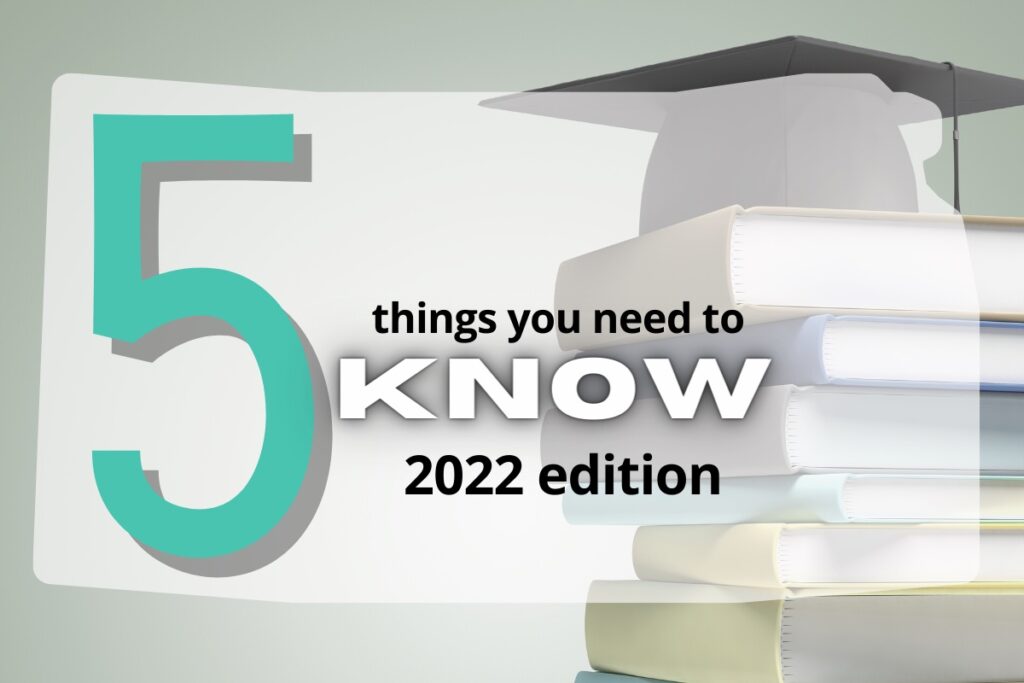[vc_row][vc_column][vc_column_text]Educational opportunities in Kansas can be amongst the best in the nation if we focus on students instead of institutions, learn from the example of states like Florida, and move past the partial truths and talking points of “supporting public schools.”
Since much of what has been written about K-12 education is either misleading or simply not true, Kansas Policy Institute is providing the following five things you need to know. The facts we cite are all provided by the Kansas Department of Education, the U.S. Department of Education, the Bureau of Labor Statistics, ACT.org, and a review of Kansas laws.
#1 – More students below grade level than proficient
State assessment tests administered by the Kansas Dept. of Education (KSDE) reflect much lower achievement than parents have been led to believe. The 2022 state assessment shows more students are below grade level than are proficient in Kansas.
Looking first at all students tested (grades 3-8 and 10), 34% of students are below grade level in math, 36% are at grade level but need remedial training, and only 30% are proficient / on track for college and career. Similar results exist in English language arts, where 34% are below grade level and just 32% proficient.
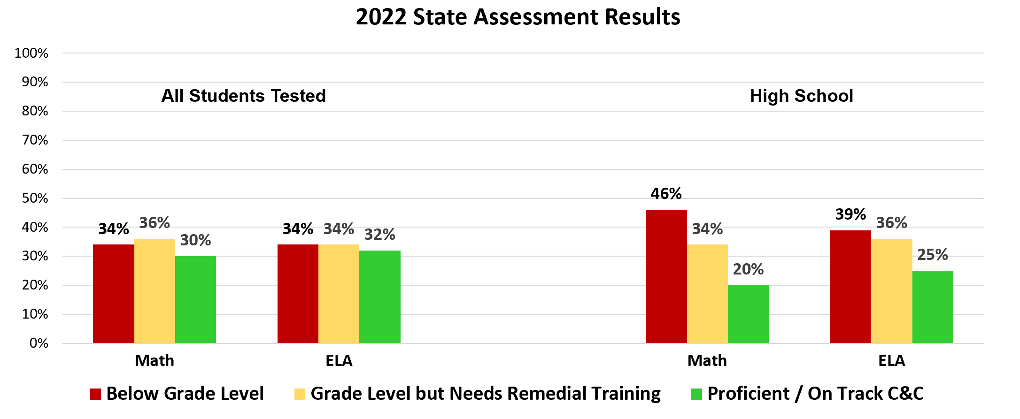 High school results are worse. For example, 46% of 10th-graders are below grade level in math and only 20% are proficient.
High school results are worse. For example, 46% of 10th-graders are below grade level in math and only 20% are proficient.
Results vary among districts, but low achievement is a universal problem across Kansas. Even in Johnson County, 34% are below grade level and only 31% are on track for college and career.
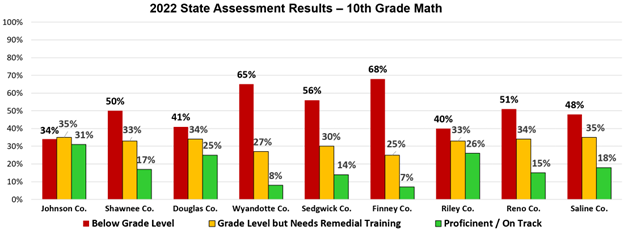 Half or more of 10th-graders in some counties are below grade level in math, including Shawnee, Wyandotte, Sedgwick, Finney, and Reno. Less than one in ten are proficient in Wyandotte and Finney counties.
Half or more of 10th-graders in some counties are below grade level in math, including Shawnee, Wyandotte, Sedgwick, Finney, and Reno. Less than one in ten are proficient in Wyandotte and Finney counties.
Achievement was on a steady decline before the pandemic, and now it’s worse.
#2 – College readiness is low and declining
The average 2022 ACT score of 19.9 in Kansas is two points lower than in 2016. It appears to be the same as in 2021, but participation last 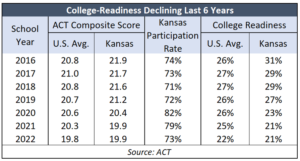 was 79% and this year it dropped to 73%. The Kansas Department of Education says participation impacts scores because students who don’t plan to attend college are less likely to take the ACT test; a decline in participation should have prompted a higher score in 2022, so the Kansas average score is likely lower than stated.
was 79% and this year it dropped to 73%. The Kansas Department of Education says participation impacts scores because students who don’t plan to attend college are less likely to take the ACT test; a decline in participation should have prompted a higher score in 2022, so the Kansas average score is likely lower than stated.
Only 21% of Kansas students did well enough to be considered college-ready in English, Reading, Math, and Science on the 2022 ACT. That’s down from 31% in 2016 and below the national average for the second consecutive year.
State average scores are skewed by two major factors – demographic differences among the states and participation rates (the percentage of students taking the ACT in each state).
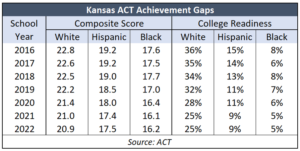 Large achievement gaps between white students and students of color and between low-income students and everyone else also skew state average scores. States with higher portions of minorities and low-income kids will appear to have lower average scores because of achievement differences.
Large achievement gaps between white students and students of color and between low-income students and everyone else also skew state average scores. States with higher portions of minorities and low-income kids will appear to have lower average scores because of achievement differences.
ACT doesn’t publish income-based demographics but the achievement gaps in Kansas between White, Hispanic, and Black students are significant and persistent. Only 5% of Black students are college-ready compared to 9% for Hispanic students and 25% for White students.
#3 – Kansas is not in the Top Ten
The Kansas Association of School Boards routinely declares Kansas to be among the ten best states for student achievement, but that has never been true. In fact, Kansas hasn’t had a single Top Ten ranking on any of the demographic measurements on the National Assessment o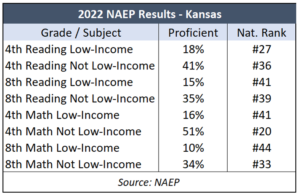 f Educational Progress (NAEP) since first participating in 1998.
f Educational Progress (NAEP) since first participating in 1998.
The state’s best ranking in 2022 is #20 (4th-grade students who are not low-income in math). One other ranking is in the 20s, three are in the 30s, and three are in the 40s. The state’s worst ranking for 8th-grade low-income students in math at #44.
Each of the eight proficiency levels in the adjacent table is lower than in 2003, and only two other states – West Virginia and Delaware – share that poor performance.
By the way, NAEP is considered the gold standard for comparing performance across states by education researchers.
#4 – Spending money does not cause achievement to improve
Contrary to claims by school officials, Supreme Court judges, and others, spending more money does not cause student achievement to improve. Per-pupil spending has grown much faster than inflation over the years, but achievement on the ACT and NAEP declined a bit. If per-pupil spending had been increased for inflation, it would have gone from about $7,000 in 1998 to about $11,600 this year, but KSDE estimates spending for the school year ended June 30, 2022, was $16,686.
Meanwhile, reading proficiency for 8th graders in Kansas dropped from 36% to 26%, and reading proficiency for 4th graders fell from 34% to 31%%.
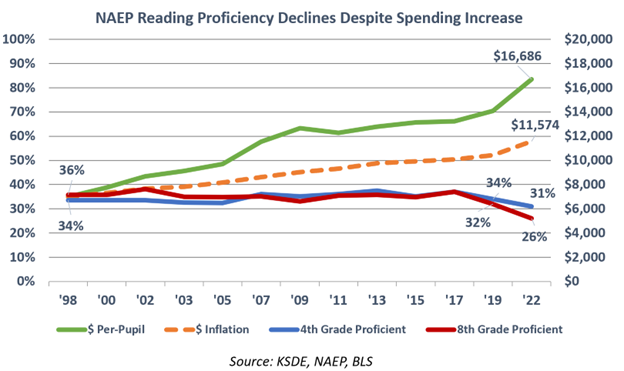 Twenty-seven states had the same or better NAEP 8-score composite in 2022 than Kansas and spent less per student (4th-grade and 8th-grade Reading and Math for low-income kids and students who are not low-income compared to 2020 spending per U.S. Census, adjusted for cost of living).
Twenty-seven states had the same or better NAEP 8-score composite in 2022 than Kansas and spent less per student (4th-grade and 8th-grade Reading and Math for low-income kids and students who are not low-income compared to 2020 spending per U.S. Census, adjusted for cost of living).
#5 – Florida’s achievement improves while Kansas goes backward
In 2003, Kansas led Florida on six of the eight primary NAEP measurements; there was one tie and Florida was ahead in measurement. But now, Florida students outperformed Kansas in every measurement. Florida is also doing better in every category, while Kansas has lower proficiency levels in every category.
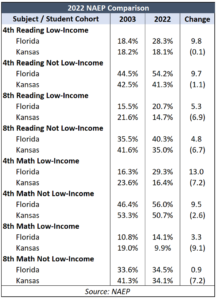 It wasn’t money that made the difference; the most recent 2020 data shows Florida spent about $4,600 less per student than the national average and about $3,700 less per student than Kansas.
It wasn’t money that made the difference; the most recent 2020 data shows Florida spent about $4,600 less per student than the national average and about $3,700 less per student than Kansas.
As explained in “Giving Kids a Fighting Chance,” Florida educators, parents, and legislators attribute their gains to a combination of choice, transparency, and accountability.
Florida has the most robust school choice offerings in the nation, including charter schools, education savings accounts, and tax credit scholarships; Kansas has one small tax credit scholarship that the education lobby wants to be eliminated.
Florida adopted an “A through F Grading System” so parents can see a letter grade on every public school and track its progress; the Kansas education lobby, as shown earlier, distorts achievement to make parents think it is much higher.
Florida has accountability measures like its 3rd-Grade Reading Initiative. The 3rd grade is critical because, in the first three years, students are learning to read; thereafter, they are reading to learn. Florida law specifies reading requirements for third-grade students and promotion to fourth-grade.
In Kansas, local school boards and administrators are not held accountable for improving student achievement or for spending money in students’ best interests. State assessment results show many students are persistently below grade level and state audits have shown money isn’t being spent as intended by the Legislature, yet there are no consequences imposed.[/vc_column_text][/vc_column][/vc_row]

